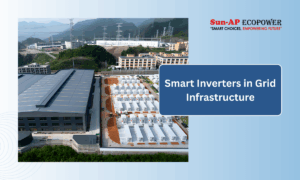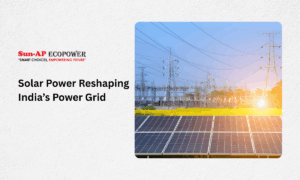Solar energy is becoming a more popular and sustainable source of energy around the world. Solar power system performance is dependent not only on the efficiency of solar panels but also on the right mounting structures that hold them in place. Solar mounting structures are critical for maximising energy production, maintaining system durability, and adapting to different installations.
This blog will look at the most prevalent types of solar mounting structures and their advantages
1. Fixed Tilt Solar Mounts:
The simplest and most cost-effective type of solar mounting structure is the fixed tilt solar mount. They are intended to keep solar panels at a constant angle throughout the year, based on the latitude of the location. During the year, the fixed tilt angle is often chosen to capture the most sunlight. While this design is simple to install and maintain, it may not be appropriate for areas with variable sunlight angles.
Benefits:
- Cost-convenient: Installation is inexpensive and simple.
- Maintenance: Low upkeep required.
- Increase solar productivity: Appropriate for installations in areas with constant solar exposure.
2. Solar Tracking Systems:
The most modern and efficient type of solar mounting structure is the solar tracking system. These systems automatically follow the sun’s movement from east to west, constantly altering the angles of the solar panels to maximise sunlight exposure. Solar tracking systems are classified into two types: single-axis trackers and dual-axis trackers.
A. Single-Axis Trackers:
Single-axis trackers move solar panels along a single axis, usually from east to west. When compared to fixed or adjustable tilt mounts, they track the sun’s movement throughout the day, optimising energy production.
Benefits:
- Leveraging More Solar Power: When compared to fixed tilt installations, energy generation is increased.
- Cost-Efficiency: When employed in large-scale solar farms, it is cost-effective.
- Location-specific: It is appropriate for flat or mildly sloping terrain.
B. Dual-axis trackers
move the solar panels along both horizontal and vertical axes, allowing for exact tracking of the sun’s position. This mounting mechanism maximises energy generation by keeping the panels perpendicular to the sun’s beams at all times.
Benefits:
- Performance: The highest potential for energy output of any mounting structure.
- Convenience: Ideal for regions with a lot of sunlight.
- Maximum Efficiency: Suitable for installations with limited area
3. RCC Roof Mounts:
RCC Roof Mounts, also known as rooftop mounts, are intended for the installation of solar panels on existing concrete roofs or slabs. These mounts are commonly employed in residential and business settings where rooftop space is used to generate solar energy.
Benefits:
- Space Utilisation: One of the key benefits of RCC Roof Mounts is their ability to properly utilise available rooftop space. Rooftop installations are an ideal alternative in metropolitan settings when ground space is restricted.
- Aesthetics: Integrating solar panels into the framework of the building creates a visually appealing and seamless look. Roof-mounted panels fit in with the building, improving the property’s overall appearance.
- Simple Maintenance: Roof-mounted solar panels are simple to maintain and clean. This accessibility lowers maintenance costs and assures peak performance throughout the system’s lifetime.
- Sunlight Exposure: Solar panels can be positioned on the roof to catch ideal sunlight exposure throughout the day, enhancing energy production efficiency.
4. Ground Mounts:
Ground Mounts are solar mounting structures that are built on open land, fields, or disused places. These mounts are particularly efficient in terms of energy generation due to their flexibility in panel orientation and tilt angle.
Benefits:
- Optimal Sun Tracking: Ground Mounts enable simple modifications to tilt angles and panel orientation, ensuring that solar panels efficiently track the position of the sun. As a result, maximum energy creation occurs throughout the day.
- Scalability: Because ground-mounted systems are easily expandable, they are ideal for large-scale solar farms and installations with possible future growth needs.
- Simple Installation: When compared to rooftop installations, installation on open ground is often easier and involves less structural considerations, making it a more cost-effective solution.
- Lower Rooftop weight: By placing the panels on the ground, the structural weight on the roof is reduced, potentially extending the building’s lifespan.
5. Solar Carports:
Solar Carports are unique constructions meant to provide shade for vehicles while also producing sustainable energy. They are typically erected in parking lots and have a dual purpose.
Benefits:
- Dual Functionality: Solar carports provide vehicle shelter while also generating clean electricity, adding value and utility to parking places.
- Parking Lot Shading: Shaded parking areas prevent heat buildup in vehicles, improving driver comfort and extending the interior life of vehicles.
- Solar carports can be constructed to complement the surrounding architecture, adding an aesthetically pleasant addition to parking spaces.
- Sustainable Image: Using solar carports shows a dedication to sustainability and renewable energy, which improves the organization’s image.
6. Shed Mounts:
Shed Mounts are solar panels that are installed on sheds or similar structures. This mounting method is widely employed for smaller-scale applications and off-grid configurations.
Benefits:
- Shed mounts are well-suited for off-grid solar systems, which provide power to distant sites or structures that do not have access to the main power grid.
- Weather Protection: Mounting solar panels atop sheds protect the underlying structure from weather elements such as rain, hail, and UV radiation, increasing the shed’s lifespan.
- Versatility: Shed mounts can be used on a wide range of structures, including small agricultural buildings, barns, and off-grid houses, making them an adaptable alternative.
Final Take with the Expertise at Sun-AP Eco Power
Sun-AP Eco Power has been in the solar industry through years of eminent and resourceful partnerships with leading solar power brands. The skilled and experienced team at Sun-AP ensures that every client be it for individual, residential requirements or for corporate, industrial, or mass volume installments, benefits the best with the solar shift. This is ensured through insightful research information to ease the choice among different products, brands, and types of solar mounts, arriving at a well-informed solar panel installation. Additionally, we assist you in any queries or support during the installation process, along with complete assistance with after-purchase maintenance as well. Sun-AP has been a leading official distributor for brands like Panasonic, DEYE, Adani, Enphase Microinverters, DEIF Controller, Livguard, Sakthi, and more.
To explore our wide range of products and get comprehensive service information, get in touch with us!




